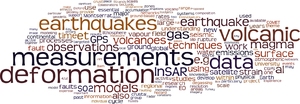NCEO:Theme 6
National Centre for Earth Observation
NCEO is a national centre funded by the Natural Environment Research Council (NERC). It is a distributed centre, meaning it is formed of small groups in numerous universities and institutions around the UK. The administration of NCEO is based at the University of Reading.
NCEO: Theme 6
NCEO: Theme 6 is a component of NCEO, developed from the Centre for the Observation and Modelling of Earthquakes, Tectonics and volcanoes (COMET+) consortium. [F 1]
EODG's contribution to COMET+ is to use EO data to measure global and regional budgets of volcanic emissions, particularly of SO2. Working with our collaborators we will integrate these measurements with regional- to local-scale measurements of volcanic emissions, ground deformation, and seismicity, to improve mathematical models for the mechanics of volcanic systems.
The SO2 data is obtained by developing algorithms for IASI and GOME-2. The ORAC algorithm will be applied to SEVIRI data to obtain ash retrievals. Novel techniques are being developed to measure ash using IASI.
Science
Volcanic SO2 is a key gas species for the planet’s radiative balance and atmospheric composition (Graf et al., 1997; Robock, 2000; Grainger and Highwood, 2003; Millard et al., 2006), and, in combination with other species, for understanding magmatic processes. Volcanic SO2 is also a significant component of the stratospheric sulphur budget (Pyle et al., 1996), however volcanic SO2 release to the atmosphere is both uncertain and variable (7–11 Tg S yr-1, Mather et al., 2003) and individual volcanic emissions can cause large local and regional perturbations. Recent developments in satellite-borne remote sensing of volcanic gases and particles allow us, for the first time, to detect and measure volcanic emissions on a global scale in near-real time. These advances will enable us to investigate the controls on these fluxes, and to understand their consequences for the Earth’s surface and atmosphere.
The processes of magma ascent and eruption depend strongly upon the evolution of the magma’s
physical properties as it partitions into melt, crystals and gas during ascent, upon the mechanical
interactions between magma and its surrounding rock, which determine the magma’s pathways through
the crust, and upon the local stress regime. We plan observations on a hierarchy of scales from the
global to the regional down to the individual volcano, to address different aspects of volcanic systems.
Oxford's output from the project is hosted on EODG website.
Footnotes [F]
- ↑ COMET+ is occasionally referred to as the DEATH theme which is an acronym of Dynamic Earth And Terrestrial Hazards.
